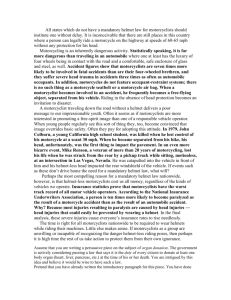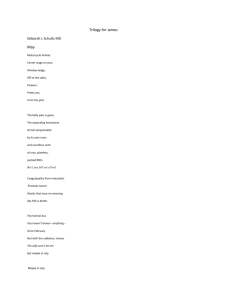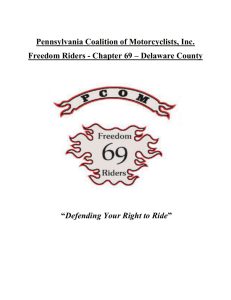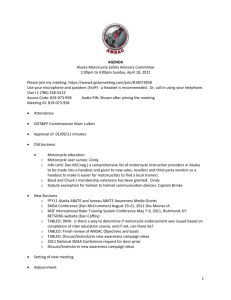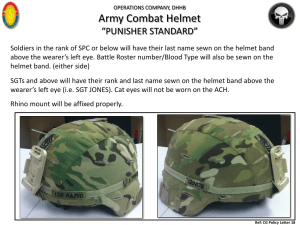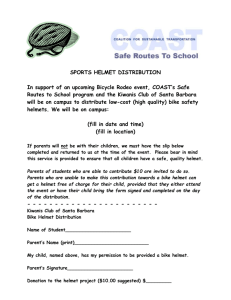Document 10465840
advertisement
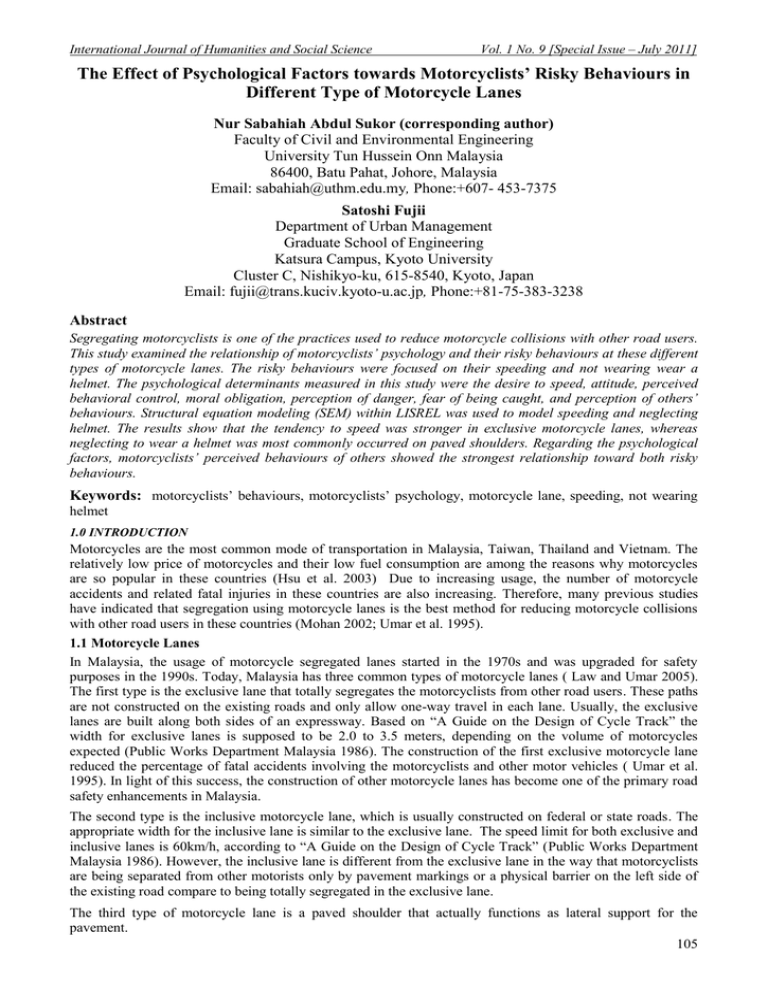
International Journal of Humanities and Social Science Vol. 1 No. 9 [Special Issue – July 2011] The Effect of Psychological Factors towards Motorcyclists’ Risky Behaviours in Different Type of Motorcycle Lanes Nur Sabahiah Abdul Sukor (corresponding author) Faculty of Civil and Environmental Engineering University Tun Hussein Onn Malaysia 86400, Batu Pahat, Johore, Malaysia Email: sabahiah@uthm.edu.my, Phone:+607- 453-7375 Satoshi Fujii Department of Urban Management Graduate School of Engineering Katsura Campus, Kyoto University Cluster C, Nishikyo-ku, 615-8540, Kyoto, Japan Email: fujii@trans.kuciv.kyoto-u.ac.jp, Phone:+81-75-383-3238 Abstract Segregating motorcyclists is one of the practices used to reduce motorcycle collisions with other road users. This study examined the relationship of motorcyclists’ psychology and their risky behaviours at these different types of motorcycle lanes. The risky behaviours were focused on their speeding and not wearing wear a helmet. The psychological determinants measured in this study were the desire to speed, attitude, perceived behavioral control, moral obligation, perception of danger, fear of being caught, and perception of others’ behaviours. Structural equation modeling (SEM) within LISREL was used to model speeding and neglecting helmet. The results show that the tendency to speed was stronger in exclusive motorcycle lanes, whereas neglecting to wear a helmet was most commonly occurred on paved shoulders. Regarding the psychological factors, motorcyclists’ perceived behaviours of others showed the strongest relationship toward both risky behaviours. Keywords: motorcyclists’ behaviours, motorcyclists’ psychology, motorcycle lane, speeding, not wearing helmet 1.0 INTRODUCTION Motorcycles are the most common mode of transportation in Malaysia, Taiwan, Thailand and Vietnam. The relatively low price of motorcycles and their low fuel consumption are among the reasons why motorcycles are so popular in these countries (Hsu et al. 2003) Due to increasing usage, the number of motorcycle accidents and related fatal injuries in these countries are also increasing. Therefore, many previous studies have indicated that segregation using motorcycle lanes is the best method for reducing motorcycle collisions with other road users in these countries (Mohan 2002; Umar et al. 1995). 1.1 Motorcycle Lanes In Malaysia, the usage of motorcycle segregated lanes started in the 1970s and was upgraded for safety purposes in the 1990s. Today, Malaysia has three common types of motorcycle lanes ( Law and Umar 2005). The first type is the exclusive lane that totally segregates the motorcyclists from other road users. These paths are not constructed on the existing roads and only allow one-way travel in each lane. Usually, the exclusive lanes are built along both sides of an expressway. Based on “A Guide on the Design of Cycle Track” the width for exclusive lanes is supposed to be 2.0 to 3.5 meters, depending on the volume of motorcycles expected (Public Works Department Malaysia 1986). The construction of the first exclusive motorcycle lane reduced the percentage of fatal accidents involving the motorcyclists and other motor vehicles ( Umar et al. 1995). In light of this success, the construction of other motorcycle lanes has become one of the primary road safety enhancements in Malaysia. The second type is the inclusive motorcycle lane, which is usually constructed on federal or state roads. The appropriate width for the inclusive lane is similar to the exclusive lane. The speed limit for both exclusive and inclusive lanes is 60km/h, according to “A Guide on the Design of Cycle Track” (Public Works Department Malaysia 1986). However, the inclusive lane is different from the exclusive lane in the way that motorcyclists are being separated from other motorists only by pavement markings or a physical barrier on the left side of the existing road compare to being totally segregated in the exclusive lane. The third type of motorcycle lane is a paved shoulder that actually functions as lateral support for the pavement. 105 The Special Issue on Contemporary Issues in Social Science © Centre for Promoting Ideas, USA www.ijhssnet.com Unlike the inclusive lane, the paved shoulder doesn’t have designated pavement markings or a barrier to show that it is a motorcycle lane. However, the use of the paved shoulder by motorcyclists is made mandatory by law and other motorists are prohibited from using the paved shoulder except in an emergency. According to the “Guide on Geometric Design of Roads” the width of the paved shoulder is variable (1.5 to 3.0 meters) and it is depending on the standards of the attached roads (Public Works Department Malaysia 1986). Even though the existence of motorcycle lanes caused a decline in motorcycle crashes involving other motor vehicles, collision problems certainly have not been resolved. In particular, accidents that occur due to motorcyclists’ mistakes are still an issue. According to Tung et al. (2008) , motorcycle crashes involving roadside objects occur even in exclusive motorcycle lanes. Many studies have focused on how the of road users is affected by the road environment, such as the influence of lane markings (Hatfield et al. 2008; Van Driel et al. 2004), road signage ( Crundall and Underwood 2001) and the introduction of the bicycle lanes ( Krizek and Roland 2005; Parkin et al. 2007). However, the effect of motorcycle lanes on the risky behaviours of motorcyclists has not been comprehensively investigated. The knowledge on such effect of motorcycle lanes on risky behaviour would be helpful for understanding the aggregated level effects of introduction of motorcycle lanes on traffic accidents including motorcycle crashes, and for designing appropriate motorcycle lanes for reducing the accidents as much as possible. 1.2 Risky Behaviours and Psychological Theories Motorcycle accidents are often associated with the motorcyclists’ risky behaviours, such as speeding and neglecting to wear a helmet. Speeding has been widely noted in previous research as one of the potential risky behaviours that could cause an accident not only for car drivers but also for motorcyclists (Aarts and Schagen 2006; Haglund and Aberg 2000; Fell 1976). In addition, Elliott et al. (2007) developed the Motorcycle Risk Questionnaire (MRBQ) and found that speed was a crash liability to the motorcyclists. The desire to speed on motorcycles was found to be similar to the desire to speed in cars. However, motorcycle crashes were more fatal. In addition, helmet usage is another important factor that needs to be addressed to reduce motorcycle fatalities. In Malaysia, helmet usage is now mandatory. Implementation of this law led to a 30% reduction in motorcycle fatalities and injuries (Supramaniam et al. 1984). Despite the law, helmets are reported as still less worn in certain areas (Krishnan1995; Kulanthayan et al. 2001; Umar 2006). In other region such as Vietnam, research regarding the relationship of helmet usage and road hierarchy found that motorcyclists were more likely to use a helmet when riding on a national road rather than on provincial roads (Hung et al. 2006). This phenomenon might have to do with enforcement of the helmet law on national roads. According to Groeger and Rotthengatter (1998), it is essential to understand the psychological factors that instigating the road users’ likeliness to involve with risky behaviours. In addition, Chesam et al. (1993) also suggested that an in-depth investigation of motorcyclist psychology and behaviours could help to figure out the internal factors that influenced the risky events. For example, the Theory of Planned Behaviour that developed by Ajzen (1991) has been widely used in studies related to risky behaviours. Among three important elements in this theory, which are; attitude, subjective norms and perceived behavioural control, only two of them were highlighted in recent study. According to Theory of Planned Behaviour, attitude is the degree of favourable or unfavourable appraisal of the objective behaviour. Meanwhile, perceived behavioural control is the degree of ease or difficulty of performing the objective behaviour. This theory has influenced many studies on risky behaviours (Elliot et al. 2003; Warner and Aberg 2006) Another robust theory that focuses on human behaviour is the Normative Social Influence Theory (Asch, 1956). This theory relates the social influences to behavioural changes of a person that influenced by perception of the actions of other people and society in general. The action of changing the behaviour for this theory is called as conformity. Conformity strategy is the process in social norms which people beliefs or behaviours are influenced by peer pressure or unconscious compulsion. Several studies on road users’ behaviours supported the theory and demonstrated that the level of conformity increased when pressure from other people increased (Caldini and Trost 1998; Zhou et al. 2009). Another psychological theory is the Norm Activation Theory, which concentrates on moral obligation context. Schwartz (1977) found that a measure of moral obligation aids in predicting behaviour and is particularly useful for recognizing participants that feel responsible. This theory has been used to measure the influence of altruism toward certain social awareness in previous studies (Choocharukul et al. 2006; Fujii and Van, 2009). Meanwhile, to investigate fear and worry related to risk taking, it is important to define human perception toward danger. Thus, the perception of risk theory is an important psychological theory related to human behaviour (Adams 1995; Slovic 2000; Wilde 2001). The theory suggests that people have a preferred level of risk where they are willing to accept and that they adjust their behaviour to maintain that preferred level of risk. 106 International Journal of Humanities and Social Science Vol. 1 No. 9 [Special Issue – July 2011] For example, as the risk increases, so does their caution toward risk. The theories that have been described above were used in many studies involving driver behaviours. However, there is still and need for a robust experimental understanding of the psychological characteristics that effect motorcyclists in developing countries. Therefore, the aim of this study was to identify the psychological factors that affecting speeding and neglect helmet actions in different types of motorcycle lanes. The rest of this paper is organized as follows. First, brief introduction is presented that covers the types of motorcycle lanes in Malaysia, the investigated risky behaviours and the psychological factors that motivated this study. The next section explains the methodology, which included a survey and a statistical analysis. This is followed by empirical results and discussion sections. Finally the paper is concluded with suggestions for future study. 2.0 METHODOLOGY 2.1 Survey From June to August, 2009, a self-reported survey was conducted of motorcyclists that used exclusive motorcycle lanes, inclusive motorcycle lanes and paved shoulders in Malaysia. This survey was designed to examine the psychological influence on risky motorcycling behaviours. Motorcyclists were randomly selected and 600 questionnaires were distributed in three specific locations. Each motorcyclist was asked to answer the questions and 595 questionnaires were returned for a respondent rate of 96%. However, after excluding missing data, only 575 complete sets of answers were available, 265 answers from motorcyclists on paved shoulders, 159 from inclusive lanes and 151 from exclusive lanes. 34% of the respondents were 16-20 years old, 29% were 21-25 years old, and 37% were more than 25 years old. 90% of the respondents used engines capacities of 70-135cc while 3% of respondents rode 250cc and larger motorcycles. In general, most of the respondents were male (78.4% male and 21.6% female). The questionnaire was designed to provide an objective study based on previous research that included measurements of risky behaviour, desire to speed, attitude, perceived behavioural control, perceived danger, fear of being caught, moral obligation and perception of others’ behaviours. The primary dependent variables in the questionnaire were speeding and neglect to wear a helmet. The respondents were asked to answer the questions “For past a month, your frequency of riding with speed exceeding 60km/h is …” and “For past a month, your frequency of riding without using helmet is…” based the answer scale “never, seldom, usually and always.” The distribution of answers related to risky s is shown in Table 1. Table 1 Distribution scores, means and standard deviations of risky behaviours Risky behaviour Type of lane Speeding Exclusive Inclusive Paved shoulder Neglect helmet Exclusive Inclusive Paved shoulder Never 11 10 13 Never 61 64 64 Distribution of scores (%) Seldom Usually Always 34 29 26 28 33 19 46 31 10 Once More than once More than 5 times 12 18 9 13 18 5 11 15 10 M/SD 2.81/0.97 2.71/0.98 2.39/0.84 1.64/0.94 1.70/1.05 1.76/1.04 In order to acquire information regarding psychological indicators, the questions regarding the psychological factors are shown in Table 2. The answers for the questions for attitude, perceived behavioural control, perceived danger, fear of being caught and moral obligation were answered using the Likert Scale of “strongly agree, agree, disagree and strongly disagree.” Meanwhile, to measure motorcyclists’ perceptions of other peoples’ behaviours, the respondents were asked to estimate the percentages of other motorcyclists that were involved in risky s with scale “0-20% , 30-40%, 50% ,60-70% 80-100%.” In addition, respondents were asked to state their desired riding speed with scale “<60km/h, 60-80km/h, 80-100km/h, >100km/h.” Table 2 Questions of psychological determinants for speeding and not wearing helmet Psychological determinants Attitude toward speeding / neglect helmet Perceived behavioural control toward speeding/neglect helmet Perceived danger of speeding/neglect helmet Fear of being caught while speeding/neglect helmet Moral obligation toward speed limit/helmet usage Perceived others’ behaviour speeding/ neglect helmet Desire to speed Speeding Speeding over the speed limit is enjoyable for me It is hard to control myself from riding at a speed that exceeds the speed limit For me, riding over the speed limit is dangerous I fear to be caught by police while I speed excessively In my opinion, one ought to ride a motorcycle with the appropriate speed limit In my opinion, the percentage of motorcyclists speeding over the speed limit is… My actual desire speed is… Not wearing helmet Wearing a helmet is not enjoyable for me It is hard for me to wear the helmet while riding the motorcycle For me, riding without wearing helmet is dangerous I fear be caught by police while I ride without using the helmet In my opinion, one ought to wear a helmet when riding a motorcycle In my opinion, the percentages of motorcyclists that not using the helmet is… - 107 The Special Issue on Contemporary Issues in Social Science © Centre for Promoting Ideas, USA www.ijhssnet.com 2.2 Statistical Analysis In this study, structural equation modeling (SEM) in LISREL 8.53 by Joreskorg and Sorkom (2001) was used for statistical analysis. Several goodness-of–fit statistics were used to judge the fit and validity of the estimated model. The goodness-of–fit index (GFI) and the root mean square error of approximation (RMSEA) were evaluated as absolute fit measures, while the normed fit index (NFI) and the comparative fit index (CFI) were taken as incremental fit indexes. As a rule of thumb, a model with NFI and CFI values greater than 0.090 is considered satisfactory, whereas the conventional values of RMSEA are below 0.10 for most acceptable models (Hair et al. 2006). However, RMSEA below 0.08 would indicate a good fit of the models. The conceptual diagram for structural equation model in this study is shown in Figure 1. Psychological factors Risky behavior Type of lanes Figure 1 Conceptual path diagram 3.0 RESULTS 3.1 Descriptive Analysis Table 3 Means and standard deviations of psychological factors for speeding and not using a helmet Risky behaviour Speeding Not using helmet Psychological determinants Attitude toward speeding Perceived behavioural control toward speeding Perception of danger toward speeding Fear of being caught while speeding Moral obligation toward not speeding Perception others speeding Desire to speed Attitude toward neglect helmet Perceived behavioural control toward neglect helmet Perception of danger toward neglect helmet Fear of being caught while neglect helmet Moral obligation toward helmet usage Perceived others neglect helmet Exclusive lane M/SD 2.15/0.96 2.02/0.86 1.99/0.96 1.82/0.81 1.74/0.80 2.79/0.78 2.98/0.85 3.11/0.82 2.99/0.75 1.46/0.67 1.64/0.86 1.60/0.72 2.09/0.96 Inclusive lane M/SD 2.63/1.01 2.55/0.96 1.81/0.94 1.75/0.78 1.66/0.78 2.74/0.76 2.46/0.95 3.19/0.74 2.99/0.75 1.67/0.75 1.71/0.83 1.52/0.63 2.23/0.99 Paved shoulder M/SD 3.12/0.74 2.65/0.74 1.56/0.74 1.66/0.71 1.60/0.71 2.65/0.87 1.87/0.78 2.91/0.98 3.17/0.72 1.81/0.81 1.66/0.79 1.59/0.78 2.31/0.87 Table 3 shows the means and standard deviations of psychological variables for three different types of motorcycle lanes. For speeding behaviour, lower mean values for attitude variable indicate that the motorcyclists enjoyed speeding. The result shows that motorcyclists in the exclusive lane were enjoyed speeding more than the motorcyclists in the other two lanes. It is also similar with perceived behavioural control where the lower mean values indicate that the motorcyclists were tended to be more easily involved with speeding, especially for motorcyclists in the exclusive lane. Contrary to the perceived danger and the fear of being caught, the lower mean values indicate motorcyclists’ high perception toward danger while speeding and more afraid of being caught by the authorities while involved with speeding. Meanwhile, for moral obligation variable, the lower mean value for motorcyclists in the paved shoulder shows they have a higher sense of obligate to the speed limit compared with the motorcyclists in the other two lanes. In addition, higher mean values for perception on others’ speeding and desire to speed indicate perception of motorcyclists in the exclusive motorcycle lanes toward other motorcyclists’ speeding behavior was higher than the other two lanes. 108 International Journal of Humanities and Social Science Vol. 1 No. 9 [Special Issue – July 2011] Besides, motorcyclists in the exclusive lane also show higher desire to speed than motorcyclists in inclusive lane and paved shoulder. For neglect helmet, the lower mean values for attitude showed that the motorcyclists were likely to use helmet. The results of the mean values for the attitude variable show that motorcyclists in the paved shoulder preferred to use helmet compared to the motorcyclists in the exclusive and inclusive lane. For perceived behavioural control toward helmet, the highest value for mean is showed by the paved shoulder. This indicates that the motorcyclists in the paved shoulder felt hard to wear a helmet while riding the motorcycle. Furthermore, mean value for perceived danger in paved shoulder is higher the other two lanes. This indicates that the rider on the paved shoulder tended to perceived less danger while not wearing a helmet. They were also less afraid of being caught by the police while not wearing a helmet. For moral obligation variable, the lowest mean value for paved shoulder indicates that they have the lowest moral obligation to use helmet. Furthermore, the result also shows that while compare to the other two lanes, the motorcyclists in the paved shoulder have higher perception that the other motorcyclists not wearing a helmet while riding. 3.2 Speeding In this study, the overall goodness of fit for both SEM models was acceptable, as suggested by Kline (1998) and Hu and Bentler (1999). For the speeding behaviour model, the maximum likelihood estimation of the model yielded a χ² value of 23.71 with 12 degrees of freedom. The chi-square/d.f of 1.99 was well below the recommended value of 3.00 and the RMSEA value of 0.04 was lower than the upper limit of 0.10. The NFI and CFI values were acceptable and exceed the cutoff value of 0.90. Figure 2 Path diagram indicating the determinants of speeding behavior To remind, in this analysis, type of motorcycle lane was analyzed as dummy variable and paved shoulder was chosen as the control group. The path model for significant relationships of speeding behaviour is shown in Figure 2. The figure shows that the dummy variable of the exclusive lane had a significant positive direct effect on speeding. In addition, this lane also had significant positive indirect effects on speeding through various psychological variables, such as desire to speed, attitude toward speed, perceived behavioural control and perceived speeding behaviour of others. On the other hand, the dummy variable of inclusive lane had no direct effect but indirectly gave positive effect on speeding behaviour mediated by desire to speed. Moreover, the results from Figure 2 also imply that the motorcyclists perceived other peoples were likely to engage with the speeding action in the exclusive lane rather than in the paved shoulder, thus influencing them to get involved with the same action. The results also indicate that the motorcyclists had high desire to speed, high attitude toward speeding and feel more easiness to accelerate in the exclusive lane than in the paved shoulder. These factors caused the motorcyclists to be more likely speeding in the exclusive lane. Meanwhile, the direct effect by the exclusive lane implies that there should be more other reasons for the motorcyclists’ likeliness to speed in the exclusive lane instead of the factors discussed above. 109 The Special Issue on Contemporary Issues in Social Science © Centre for Promoting Ideas, USA www.ijhssnet.com In addition, the result for dummy variable of inclusive lane in Figure 2 implies that the motorcyclists also had the intention to speed in the inclusive lane. However, the likeliness to speed would only because their stronger desire to accelerate in the inclusive lane rather than in the paved shoulder. 3.3 Not wearing a helmet Figure 3 Path diagram indicating the determinants of helmet usage Regarding the tendency to not wear a helmet, a review of the goodness-of-fit statistic shows that the model provides a reasonably good fit to the data. The maximum likelihood estimation of this model yielded a χ² value of 22.62 with 5 degree of freedom. The chi-square/d.f of 1.86 was below the recommended value of 3.00. Meanwhile, the RMSEA value of 0.08 was lower than the upper limit 0.10 with NFI and CFI values exceed the cutoff value of 0.90. The path model for significant correlations regarding helmet usage is shown in Figure 3. The statistical analysis showed that none of the motorcycle lanes were significantly related to neglecting to wear a helmet except for the indirect relation from the exclusive lane. The dummy variable of exclusive lane was indirectly and negatively affected to not wearing helmet through motorcyclists’ negative attitudes toward helmet usage. The negative attitude variable reveals that the tendency of neglecting to wear a helmet increased while the negative attitude toward helmet usage increased. However, in the exclusive lane, the result shows that the negative attitude toward helmet usage is converse with the paved shoulder. This would be the reason for the respondents’ answers that they would more likely to use the helmet in the exclusive lane. In the inclusive lane, a significant influence was found between motorcyclists’ perception toward danger and riding without using a helmet. This result indicates that the motorcyclists perceived that neglecting to wear a helmet while riding in the inclusive lane could lead them to danger. However, the perceived danger variable was not significantly related to helmet usage. Perceived behavioural control and perceived behaviour of others also significantly affected helmet usage. The standardized coefficient values show that perceived behaviour of others had the strongest relationship with helmet usage. This indicated that the perception that most other riders wore a helmet increased motorcyclists’ tendencies to wear their helmet. Meanwhile, the positive coefficient of perceived behavioural control implied that those who found it difficult to comply with helmet usage laws would have an increased tendency to abandon the helmet. 4.0 DISCUSSION In Malaysia, motorcycle lanes have been constructed to segregate motorcyclists from other motor vehicles. This study examined the effects of different types of motorcycle lanes on motorcyclists’ psychological factors and their risky behaviours. The investigated risky behaviourals, such as speeding and neglecting to wear a helmet, were chosen due to the increased risk of motorcycle fatality associated with each action (Chang et al. 2007; Lin, Chang et al. 2003; Haglund et al. 2000; Pang et al. 1999). Findings from this study demonstrated that the exclusive motorcycle lane had the highest impact on encouraging the speeding behaviour, followed by the inclusive lane and then the paved shoulder. Meanwhile, the findings were reversed for helmet usage. Motorcyclists tended to abandon the helmet most frequently while riding on the paved shoulder, followed by the inclusive lane and then the exclusive lane. Results from the structural equation model revealed that only the exclusive lane was found to significantly affect the speeding behaviour directly. 110 International Journal of Humanities and Social Science Vol. 1 No. 9 [Special Issue – July 2011] This finding indicated that when using the exclusive lane, motorcyclists tend to speed. This is congruent with a previous study that found speeding to be preferable in an environment where the road is straight, wide and perceived as safe ( Goldenbeld and Schagen, 2007). In addition, the exclusive motorcycle lane is totally separated from other motorists. This special condition might have increased motorcyclists’ perceptions of safety. In this study, perception of safety was explained by the perceived danger variable. Compared to the exclusive lane, motorcyclists perceived more danger while speeding on paved shoulders. This might be because other vehicles can intrude on the paved shoulder. Motorcyclists’ tendencies to engage in risky behaviours were also mediated by psychological factors, which are described in the paragraphs below. The perception of others’ behaviours was the strongest influencing psychological factor for the speeding model. This finding revealed that motorcyclists tended to perceive that other motorcyclists were likely to speed. This perception influenced motorcyclists to engage in the same action. This finding has been demonstrated in several other studies (Fleiter et al. 2010; Forward 2009; Rosenbloom 2009; Yechiam 2008). The same psychological factor also had the strongest impact on helmet usage. However, the variable was not related to motorcycle lane type. In addition, attitude and perceived behavioural control were also found to be significantly related to both risky behaviors. Negative attitudes and perceived control toward speeding were mediated between the exclusive lane and by speeding . Both factors are the elements in Theory of Planned Behaviour , which has been proven to be the main factor influencing the existence of a in previous studies (De Pelsmacker and Janssens 2007; Elliot et al. 2003; Warner et al. 2006). For the helmet usage model, negative attitudes toward using a helmet mediated the relationship between paved shoulder and helmet usage. Meanwhile, the relationship between perceived behavioral control and helmet usage was found to have no relationship with motorcycle lane type. For the speeding model, the desire to speed was another affecting factor that mediated the exclusive lane and speeding behaviour relationship. This finding is similar to study by Goldenbeld et al. (2007), which indicated that a higher desire to speed leads to a higher tendency to speed. 5.0 CONCLUSION Firstly, this recent study revealed that the tendency to speed was increased in exclusive motorcycle lanes. Many previous studies have suggested that road width might influence driving speed (Lewis-Evans and Charlton 2006; Pau and Angius 2001). The findings from this recent study provide additional insight to help researchers, authorities and policy makers figure out the appropriate speed limit for motorcycle lanes. For the time being, the design speed for motorcycle lanes in Malaysia is 60km/h but the motorcyclists’ desired speed was found to be higher. Therefore, in order to overcome the excessive speeding in motorcycle lanes, it is needed to create cues that would enhance motorcyclists’ sense of their speed. The basic idea behind this approach is to applied perceptual modification which is visual illusions stripes across the road with diminishing distance between them. Example of the perceptual modifications that usually installed on the roads are herringbone lane markings and widening the edge lines in the apex of curve. On the other hand, motorcycle lane types were not found to be directly related to helmet usage. Whether motorcyclists are driving in an urban or rural area and the type of road being used are factors that might have more impact on their helmet usage. (Kulanthayan et al. 2001; Swaddiwudhipong et al. 1998; Hung et al. 2006) Based on findings from psychological influences to risky behaviours in this recent study, it is recommended for future study to investigate the effect of implementing a conformity strategy in order to reduce neglect helmet and speeding behaviours. According to conformity strategy, to increase the propensity to use a helmet, motorcyclists should be persuaded that other motorcyclists tend to comply with helmet usage laws. The same strategy might also be applied to reducing the excessive speeding action. 6.0 REFERENCES Aarts, L., & Van Schagen, I. (2006). Driving speed and the risk of road crashes: A review. Accident Analysis and Prevention, 38, 215-224. Adams, J. (1995). Risk. London and New York: Taylor & Francis. Ajzen, I. (1991). The Theory of Planned . Organizational and Human Decision Processes, 50, 179-211. Asch, S. E. (1956). Studies of Independence and Conformity .1. A Minority of One against a Unanimous Majority. Psychological Monographs, 70, 1-70. Bellaby, P., & Lawrenson, D. (2001). Approaches to the risk of riding motorcycles: reflections on the problem of reconciling statistical risk assessment and motorcyclists' own reasons for riding. Sociological Review, 49, 368-388. Caldini, R. B. A., & Trost, M. R. (1998). Social Influence: Social Norms, Conformity, and Compliance. In D. T. Gilbert, S. T. Fiske & G. Lindzey (Eds.), The Handbook of Psychology (4 ed., Vol. 2). 111 The Special Issue on Contemporary Issues in Social Science © Centre for Promoting Ideas, USA www.ijhssnet.com Chang, H. L., & Yeh, T. H. (2007). Motorcyclist accident involvement by age, gender, and risky s in Taipei, Taiwan. Transportation Research Part F-Traffic Psychology and Behaviour, 10, 109-122. Chesham, D. J., Rutter, D. R., & Quine, L. (1993). Motorcycling Safety Research - A Review of the Social and al Literature. Social Science & Medicine, 37, 419-429. Choocharukul, K., Van, H. T., & Fujii, S. (2006). Psychological Determinats Of Moral Obligation Of Car Use Reduction And Acceptance Of Car Use Restriction In Japan And Thailand. IATSS Research, 30, 7076. Crundall, D., & Underwood, G. (2001). The priming function of road signs. Transportation Research Part F: Traffic Psychology and Behaviour, 4, 187-200. De Pelsmacker, P., & Janssens, W. (2007). The effect of norms, attitudes and habits on speeding : Scale development and model building and estimation. Accident Analysis and Prevention, 39, 6-15. Elliot, M. A., Baughan, C. J., & Armitage, C. J. (2003). Drivers’ compliance with speed limis: Appication of the Theory of Planned . Journal of Applied Psychology, 88, 964 - 972. Elliott, M. A., Baughan, C. J., & Sexton, B. F. (2007). Errors and violations in relation to motorcyclists' crash risk. Accident Analysis and Prevention, 39, 491-499. Faezi, S. F., & Hamid, H. (2010). The effect of pavement marking on speed reduction in exclusive motorcycle lane in Malaysia. Contemporary Engineering Sciences, 3, 149 -155. Fell, J. C. (1976). Motor Vehicle Accident Causal System - Human Element. Human Factors, 18, 85-94. Fleiter, J. J., Lennon, A., & Watson, B. (2010). How do other people influence your driving speed? Exploring the 'who' and the 'how' of social influences on speeding from a qualitative perspective. Transportation Research Part F-Traffic Psychology and Behaviour, 13, 49-62. Forward, S. E. (2009). The theory of planned behaviour: The role of descriptive norms and past behaviour in the prediction of drivers' intentions to violate. Transportation Research Part F-Traffic Psychology and Behaviour, 12, 198-207. Fujii, S., & Van, H., .T. (2009). Psychological determinants of the intention to use bus in Ho Chi Minh City. Journal of Public Transportaion, 12, 97-110. Goldenbeld, C., & Van Schagen, I. (2007). The credibility of speed limits on 80 km/h rural roads: The effects of road and person(ality) characteristics. Accident Analysis and Prevention, 39, 1121-1130. Groeger, J. A., & Rotthengatter, J. A. (1998). Traffic psychology and behaviour Transportation Research Part F: Traffic Psychology and Behaviour, 1, 1-9. Haglund, M., & Aberg, L. (2000). Speed choice in relation to speed limit and influences from other drivers. Transportation Research Part F: Traffic Psychology and Behaviour, 3, 39-51. Hair, J. F., Black, W. C., Babin, B. J., Anderson, R. E., & Tatham, R. L. (2006). Multivariate Data Analysis (6th Edition ed.).USA: Prentice Hall. Hatfield, J., Murphy, S., & Job, R. F. S. (2008). Beliefs and behaviours relevant to the road safety effects of profile lane-marking. Accident Analysis and Prevention, 40, 1872-1879. Hsu, T. P., Sadullah, E. A. F. M., & Dao, I. N. X. (2003). A comparison study on motorcycle traffic development in some Asian countries-case of Taiwan, Malaysia and Vietnam. Hu, L., & Bentler, P. M. (1999). Cutoff criteria for fit indexes in covariance structure analysis: Conventional criteria versus new alternatives. . Structural Equation Modeling, 6, 1-55. Hung, D. V., Stevenson, M. R., & Ivers, R. Q. (2006). Prevalence of helmet use among motorcycle riders in Vietnam. Injury Prevention, 12, 409-413. Joreskorg, K., & Sorbom, D. (2001). LISREL : User's Reference Guide. Chicago: Scientific Software International (SSI). Kline, R. B. (1998). Principles and practices of structural equation modeling. New York: Guilford. Krishnan, K. (1995). 36th Annual Greeting Meeting Report: National Road Safety Council, Malaysia, Kuala Lumpur. Krizek, K. J., & Roland, R. W. (2005). What is at the end of the road? Understanding discontinuities of onstreet bicycle lanes in urban settings Transportation Research Part D: Transport and Environment, 10(1), 55-68 Kulanthayan, S., Radin Umar, R. S., Ahmad Hariza, H., & M.T, M. N. (2001). Modeling of Compliance of Motorcyclists to Proper Usage of Safety Helmets in Malaysia. Traffic Injury Prevention, 2, 239 - 246. Law, T. H., & Radin Sohadi, R. S. (2005). Determination of comfortable safe width in an exclusive motorcycle lane. Journal of the Eastern Asia Society for Transportation Studies, 6, 3372-3385. 112 International Journal of Humanities and Social Science Vol. 1 No. 9 [Special Issue – July 2011] Lewis-Evans, B., & Charlton, S. G. (2006). Explicit and implicit processes in behavioural adaptation to road width. Accident Analysis and Prevention, 38, 610-617. Lin, M. R., Chang, S. H., Pai, L., & Keyl, P. M. (2003). A longitudinal study of risk factors for motorcycle crashes among junior college students in Taiwan. Accident Analysis and Prevention, 35, 243-252. Mohan, D. (2002). Road safety in less-motorized environments: future concerns. International Journal of Epidemiology, 31, 527-532. Pang, T. Y., Umar, R., Aziz, A. A., & Singh, H. (1999). Non-fatal injuries in Malaysian motorcyclists. International Medical Research Journal, 3, 111 -114. Parkin, J., Wardman, M., & Page, M. (2007). Models of perceived cycling risk and route acceptability. Accident Analysis and Prevention, 39, 364-371. Pau, M., & Angius, S. (2001). Do speed bumps really decrease traffic speed? An Italian experience. Accident Analysis and Prevention, 33, 585-597. Roads Branch, P. W. D. M. A Guide on Geometric Design of Roads: Arahan Teknik (Jalan) 8/86. Roads Branch, P. W. D. M. A Guide on the Design of Cycle Track: Arahan Teknik (Jalan) 10/86. Rosenbloom, T. (2009). Crossing at a red light: Behaviour of individuals and groups. Transportation Research Part F-Traffic Psychology and Behaviour, 12, 389-394. Schwartz, S. H. (1977). Normative influences on altruism. In L. Berkowitz (Ed.), Advanced in experimental social psychology (Vol. 10, pp. 222-280). New York: Academia Press, Inc. Slovic, P. (2000). The Perception of Risk. London and Sterling, VA: Earthscan. Supramaniam, V., Vanbelle, G., & Sung, J. F. C. (1984). Fatal Motorcycle Accidents and Helmet Laws in Peninsular Malaysia. Accident Analysis and Prevention, 16, 157-162. Swaddiwudhipong, W., Boonmak, C., Nguntra, P., & Mahasakpan, P. (1998). Effect of motorcycle rider education on changes in risk behaviours and motorcycle-related injuries in rural Thailand. Tropical Medicine & International Health, 3, 767-770. Tung, S. H., Wong, S. V., Law, T. H., & Umar, R. S. R. (2008). Crashes with roadside objects along motorcycle lanes in Malaysia. International Journal of Crashworthiness, 13, 205-210. Umar, R. S., Mackay, M. G., & Hills, B. L. (1995). Preliminary analysis of exclusive motorcycle lanes along the federal highway F02, Shah Alam, Malaysia. IATSS Research, 19. Umar, R. S. R. (2006). Motorcycle safety programmes in Malaysia: how effective are they? International Journal of Injury Control and Safety Promotion, 13, 71 - 79 Van Driel, C. J. G., Davidse, R. J., & Van Maarseveen, M. F. A. M. (2004). The effects of an edgeline on speed and lateral position: a meta-analysis. Accident Analysis and Prevention, 36, 671-682. Warner, H. W., & Aberg, L. (2006). Drivers' decision to speed: A study inspired by the theory of planned . Transportation Research Part F-Traffic Psychology and Behaviour, 9, 427-433. Wilde, G. J. S. (2001). Target Risk 2: A New Psychology of Safety and Health :What works, what doesn't and why? Toronto: PDE Publications. Yechiam, E., Druyan, M., & Ert, E. (2008). Observing others' and risk taking in decisions from experience. Judgment and Decision Making Journal, 3, 493-500. Zhou, R. G., Horrey, W. J., & Yu, R. F. (2009). The effect of conformity tendency on pedestrians' roadcrossing intentions in China: An application of the theory of planned . Accident Analysis and Prevention, 41, 491-497. 113
